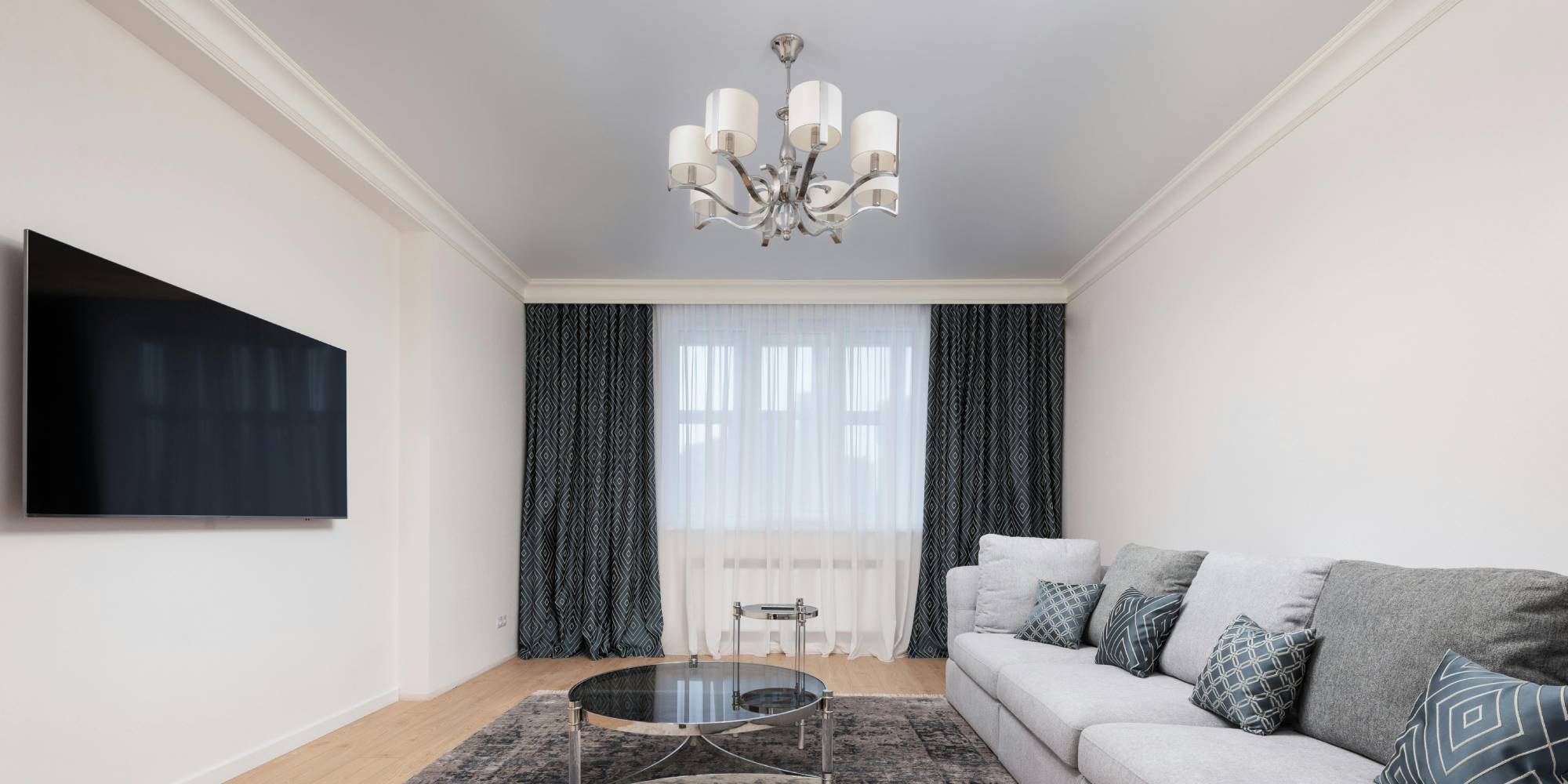Table of Contents
Key Takeaways
✔ A popcorn ceiling is a bumpy finish used in older homes to hide flaws and reduce noise.
✔ A textured ceiling uses patterns like knockdown or swirl to add style and visual interest.
✔ Popcorn ceilings are low-cost and good for coverage, but look dated and are hard to clean.
✔ Textured ceilings are stylish and versatile but can be tricky to repair and often need a pro.
✔ Popcorn suits older, budget-focused spaces; textured fits modern or updated interiors.
✔ Pick popcorn for quick coverage, noise control, or uneven ceilings.
✔ Pick textured for a cleaner look, easier upkeep, and design flexibility.
Ceilings have a big impact on how a room looks and feels. Whether it’s a smooth surface or a decorative texture, the ceiling can tie a design together or make a space feel dated. Two of the most common ceiling finishes—popcorn and textured—each come with their own pros, cons, and style considerations. Making the right choice not only affects aesthetics but can also influence property value.
Interior upgrades like ceiling refinishing can contribute to the overall appeal of a home. The average return on investment (ROI) for interior painting is around 107%, potentially adding anywhere from $2,140 to $16,050 in resale value, depending on the project scale and market.
Here are the key differences between popcorn and textured ceilings—and how to decide which one fits the home best.

What Is a Popcorn Ceiling?
A popcorn ceiling is a type of textured ceiling finish that features a bumpy, uneven surface resembling cottage cheese or popcorn. It was commonly used in residential construction from the 1950s through the 1980s. This texture was sprayed onto ceilings using a mixture that often included materials like drywall compound, polystyrene, or even asbestos in older homes.
Common Materials and Application Methods
The original popcorn ceiling mixture was typically made using a blend of materials that could easily be sprayed onto ceilings. The goal was to save time during construction and cover flaws without the need for sanding.
- Acoustic Ceiling Spray: Often made with a mix of drywall mud, Styrofoam, and, in older homes, asbestos for fire resistance. This combination added soundproofing and visual coverage with one step.
- Spray Gun Application: Builders used a hopper spray gun to apply the mixture directly onto drywall ceilings. It required no smoothing or finishing, making it a fast and affordable option during large-scale housing booms.
- Minimal Finishing Work: Unlike smooth ceilings that demand careful sanding and joint work, popcorn ceilings needed very little refinement. This reduced labor and material costs, which made them highly appealing in budget builds.
Why Popcorn Ceilings Were Popular
During the mid-20th century, popcorn ceilings were seen as practical and stylish. Builders appreciated how quick and inexpensive they were to apply, while homeowners liked the added benefits.
- Sound Dampening: The texture absorbed sound well, making rooms quieter and more comfortable. This acoustic benefit is still part of the pros and cons of ceiling textures discussions today.
- Hides Imperfections: The thick, uneven layer easily masks surface cracks, nail marks, and other flaws. Because of this, it was a go-to choice for homes needing quick cosmetic fixes.
- Cost-Effective: Popcorn ceilings saved builders time and money due to their simple application. In the comparison of popcorn ceiling vs knockdown texture, popcorn often wins for low upfront cost.
Pros and Cons of Popcorn Ceilings
Popcorn ceilings, also known as acoustic ceilings, were a popular ceiling finish for homes built from the 1950s through the 1980s. These ceilings have a distinctive bumpy texture and were commonly used in residential construction due to their convenience and affordability.
When comparing popcorn ceiling vs textured ceiling options, understanding the strengths and weaknesses of each helps homeowners make the right choice for their space.
Pros of Popcorn Ceilings
✔ Hides Imperfections Easily
✔ Provides Sound Dampening
✔ Budget-Friendly Option
Cons of Popcorn Ceilings
✖ Outdated Appearance
✖ Hard to Clean and Maintain
✖ Possible Asbestos Risk

What Is a Textured Ceiling?
A textured ceiling is a finishing style where patterns or designs are added to the ceiling surface, creating visual interest and helping to hide imperfections. Unlike a smooth ceiling, a textured finish gives depth and character to a space and is often used as a decorative feature in both modern and traditional homes.
Common Types of Textured Ceilings
Textured ceilings come in various styles, each offering a different visual effect and level of maintenance. These are a few of the most popular options:
- Knockdown Ceiling Texture: A flattened version of a splatter texture that creates a mottled, stucco-like finish. It blends a modern look with subtle depth, making it a favorite in the popcorn ceiling vs knockdown texture comparison.
- Swirl Texture: This style features spiral or circular patterns, often applied with a brush or sponge. It’s often used in hallways and dining rooms to give a soft, flowing appearance that adds elegance.
- Stomp Texture: A bold and uneven design made by stamping a pattern into wet joint compound using a stomp brush. The result is a rough and raised surface that adds a rustic or dramatic element to the room.
- Slap Brush Texture: This involves slapping a brush onto a ceiling covered with joint compound, creating a spiky and rugged pattern. It adds texture without being too heavy and works well in casual living spaces.
Materials and Application Techniques
Creating a textured ceiling involves specific tools and materials. The application method can vary based on the type of texture chosen.
- Joint Compound: The base material used for almost all textures. It spreads easily and can be manipulated into a variety of ceiling patterns before hardening.
- Specialty Brushes and Trowels: These tools create different effects and are essential for achieving accurate texture designs. For instance, knockdown textures need a wide trowel to smooth out sprayed compounds, helping to define the knockdown ceiling texture.
- Spray Machines (for Knockdown): Used to spray the compound onto the ceiling before it’s flattened with a blade or knife. This technique is a major step in both knockdown ceiling texture and older popcorn ceiling applications, but the results differ significantly in appearance.
- Manual Application: Some textures, like swirls or stomp designs, require skilled handwork to create clean and artistic results. This method allows for more creative expression and personal customization.
Why Homeowners Choose Textured Ceilings
Textured ceilings are chosen for more than just style—they offer practical benefits, too. Here are a few reasons people opt for this finish:
- Hides Flaws Easily: Textures help conceal cracks, dents, or uneven drywall, making them ideal for older homes or ceilings with minor damage. This makes them a go-to option in discussions about the pros and cons of ceiling textures.
- Adds Character: Textured ceilings can bring personality to a space, especially with styles like swirl or stomp that break away from plain, flat surfaces. These finishes offer visual interest and help define the room’s design.
- Customizable Styles: With many texture types available, homeowners can choose something subtle or bold to match their decor. This flexibility is what makes textured ceilings so appealing in both traditional and modern ceiling texture styles.
- Cost-Effective Option: Many textured ceilings are cheaper than full ceiling replacements and add value with minimal expense. It’s a budget-friendly way to update the look of a room while addressing surface imperfections.
Pros and Cons of Textured Ceilings
Textured ceilings offer a range of design options that can complement different home styles. Unlike the more dated popcorn finish, modern ceiling texture styles give homeowners flexibility and a more up-to-date appearance. When comparing popcorn ceiling vs textured ceiling, it’s important to weigh both the visual and practical aspects.
Pros of Textured Ceilings
✔ Stylish and Customizable
✔ Modern Appeal
✔ Easier to Maintain Than Popcorn
Cons of Textured Ceilings
✖ Difficult to Repair
✖ Not Ideal for DIY
✖ Higher Labor Costs

Style Compatibility: Popcorn Ceiling vs Textured Ceiling
When updating a home, the ceiling style plays a big role in how the space looks and feels. The choice between a popcorn ceiling vs textured ceiling often depends on the home’s age, style preferences, and renovation goals. Each type of ceiling fits better in certain design settings and lifestyle needs.
Popcorn Ceilings in Retro and Budget-Friendly Homes
Popcorn ceilings were widely used in homes from the 1950s to the 1980s for their practicality and affordability. While not as popular today, they still offer benefits for specific types of interiors, especially those focused on cost-efficiency or vintage appeal.
- Retro-Style Homes: Popcorn ceilings match the original features of mid-century homes and help preserve a period-correct aesthetic. They are often used in remodels where maintaining historical charm is important.
- Budget Renovations: These ceilings are inexpensive and fast to install, making them ideal for low-cost remodels or rental property updates. Homeowners looking to save on ceiling work often consider this option when comparing popcorn ceiling vs knockdown texture.
- Sound Reduction Goals: The thick texture helps absorb sound, reducing echo in rooms with hard flooring or high ceilings. It is especially useful in multi-family buildings or second-story rooms.
- Hiding Ceiling Flaws: Popcorn ceilings easily cover up ceiling defects like patches, cracks, or uneven drywall. This makes them a quick solution for cosmetic ceiling repairs during renovation.
Textured Ceilings for Modern and Custom Interiors
Today’s ceiling textures are more versatile and visually appealing than older styles like popcorn. Styles such as knockdown ceiling texture offer a clean, modern look while still adding subtle dimension to ceilings.
- Contemporary Homes: Knockdown textures and other modern finishes complement minimal, clean-lined decor in contemporary spaces. These ceiling styles support a smooth, refined aesthetic that feels current.
- Custom Home Designs: Textured ceilings allow for creative expression through patterns and finishes tailored to the homeowner’s taste. They help bring visual interest to ceilings while coordinating with custom lighting or trim.
- Transitional Spaces: Light, understated ceiling textures work well in transitional homes that blend traditional and modern styles. They add warmth and character without overwhelming the overall design.
- Open Floor Plans: In large, open spaces, consistent ceiling texture can visually connect rooms and create a unified look. Homeowners choosing between popcorn ceiling vs textured ceiling often prefer the seamless flow that textured finishes provide.
Choose Popcorn Ceiling If…
✔ The Ceiling Has Cracks or Imperfections
Popcorn ceilings are known for covering up uneven surfaces, stains, or small cracks. Their thick, bumpy texture hides flaws without needing a smooth finish underneath, making them a smart choice for older or damaged ceilings.
✔ The Project Budget Is Limited
For cost-conscious renovations, popcorn ceilings are often more affordable than other ceiling types. They use less labor and materials, making them one of the cheapest ways to finish a ceiling.
✔ Sound Control Is Important
Popcorn ceilings help reduce noise by absorbing sound. This makes them useful in bedrooms, basements, or multi-story homes where keeping noise down is a priority.
✔ A Quick and Easy Application Is Needed
Popcorn texture can be applied fast without much prep work. This speeds up renovation timelines and is ideal for anyone looking to update a room without spending extra time or money.
✔ The Home Has a Retro or Vintage Style
Homes built in the mid-1900s often had popcorn ceilings. Keeping or adding this style can help maintain the original look of the space without major updates.
Choose Textured Ceiling If…
✔ A More Modern or Stylish Look Is the Goal
Textured ceilings offer design flexibility and a cleaner appearance. Styles like swirl, stomp, or knockdown ceiling texture fit well with modern or transitional interiors and add visual interest to the room.
✔ The Ceiling Surface Is Already Smooth
Unlike popcorn, textured ceilings need a clean, even base. If the ceiling is in good condition, textured finishes can be applied directly to give it a unique but polished appearance.
✔ Cleaning and Maintenance Are a Concern
Textured ceilings are easier to maintain. Many styles are flatter and collect less dust than popcorn, which makes cleaning simpler over time.
✔ Long-Term Style and Value Are Priorities
When comparing popcorn ceiling vs knockdown texture, knockdown is often more appealing to today’s buyers. It adds a subtle, finished look that holds up better over the years and aligns with current trends.
✔ Custom Design Is Wanted
There are many modern ceiling texture styles available, which allow for more creativity and personal style. Each pattern brings its vibe to a space, giving homeowners more control over the final look.
Frequently Asked Questions
How to tell if a textured ceiling has been painted?
A painted textured ceiling usually looks sealed or glossy and may appear more solid or discolored in spots. If the texture feels hard or flakes off in chunks when scraped lightly, it’s likely been painted. Unpainted ceilings are more powdery and fragile. Painting makes removal harder because it seals the material.
Do popcorn ceilings devalue a house?
Yes, popcorn ceilings can lower a home’s value, especially in competitive real estate markets. Many buyers see them as outdated and a sign of older construction. They may also assume asbestos risks or extra work to remove the texture. Modern finishes are generally preferred for resale appeal.
Is it better to have a smooth or textured ceiling?
Smooth ceilings are better for modern looks and are easier to clean and maintain. Textured ceilings, like knockdown, can hide flaws and add character, but may be harder to repair. The better choice depends on the home’s condition and design style. Smooth is often favored in newer or high-end homes.
Why are popcorn ceilings no longer popular?
Popcorn ceilings fell out of favor due to their dated appearance and difficulty in cleaning. Concerns about asbestos in older applications also reduced their appeal. Modern design trends favor smoother, cleaner finishes. They’re also hard to repair and repaint without making a mess.
Do all textured ceilings have asbestos?
Not all textured ceilings have asbestos, but many popcorn ceilings installed before the mid-1980s do. It’s impossible to tell by looking—only lab testing can confirm it. If the home was built after 1985, it’s less likely. Still, it’s safest to test before disturbing any textured ceiling.
Get Ceiling Painting Handled by Experts in Westport, CT!
Take the stress out of ceiling updates with professional help from Custom Colonial Painting, serving Westport, CT, with precision and care. Whether it’s refreshing a textured surface or painting over an old popcorn ceiling, expert craftsmanship ensures clean lines, even coverage, and long-lasting results. Property owners in Westport, CT, trust Custom Colonial Painting for reliable, high-quality ceiling painting that enhances both style and value.
Request a free quote today and schedule professional ceiling painting in Westport, CT!



